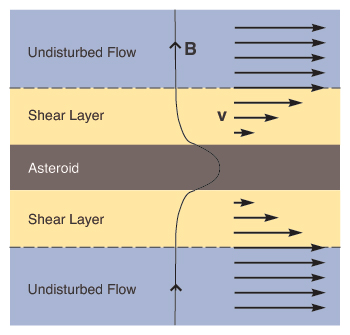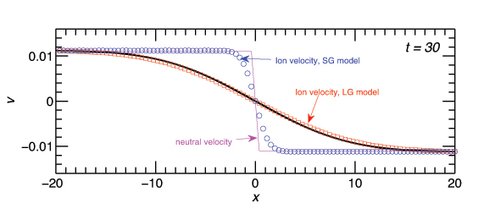2010 Annual Science Report
 Rensselaer Polytechnic Institute
Reporting | SEP 2009 – AUG 2010
Rensselaer Polytechnic Institute
Reporting | SEP 2009 – AUG 2010
Project 2: Processing of Precometary Ices in the Early Solar System
Project Summary
The discovery of numerous planetary systems still in the process of formation gives us a unique opportunity to glimpse how our own solar system may have formed 4.6 billion years ago. Our goal is to test the hypothesis that the building blocks of life were synthesized in space and delivered to the early Earth by comets and asteroids. We use computers to simulate shock waves that energize the gas and dust in proto-planetary disks and drive physical and chemical processes that would not otherwise occur. Our work seeks specifically to determine (i) whether asteroids and comets were heated to temperatures that favor prebiotic chemistry; and (ii) whether the requisite heating mechanisms operate in other planetary systems forming today.
Project Progress
Precometary Ices in Molecular Clouds and Cores – The 5-year objective of this project is to study thermal processing of precometary materials in the solar nebula and protoplanetary disks. In Year 2 we made important contributions to the physics of two heating mechanisms – multifluid, magnetohydrodynamic shock waves and a new electrodynamic process discovered by us.
Figure 1 – Grain Dynamics in Multifluid MHD Shock Waves. Velocity profile of a multfluid shock produced when a 20 km/s protostellar jet impacts a molecular cloud core. Abcissa: position in units of the characteristic length scale (~1 AU) for ion-neutral coupling, Ordinate: velocities of the neutral (magenta curve) and charged (red and blue symbols) components of the plasma in units of the ion-Alfven speed (~1000 km/s). The different symbols describe models where the dust is effectively absent (red) or present (blue).
a) Multifluid, Magnetohydrodynamic Shock Waves
Roberge, Ciolek, and grad student Max Katz modeled the dynamical effects of dust grains on multifluid MHD shock waves. Fig. 1 describes the shock produced when a 20 km/s protostellar jet impacts a molecular cloud core. The shock consists of a sharp discontinuity (J shock) in the neutral component of the plasma (magenta curve) plus smooth disturbances in the charged particles (red and blue symbols). The response of the charged particles is shown for two cases, where dust is either effectively absent (red) or present (blue). Multifluid shocks are heated primarily by friction associated with differential motions between charged and neutral particles. Consequently, the discrepancy between the red and blue solutions shows that models of shock heating require realistic treatments of grain dynamics. This result should have a large impact on studies of shock-heated molecules around protostars, e.g., by SOFIA.

Figure 2 – A New Electrodynamic Heating Mechanism. The relative motion between a large solid body and surrounding plasma- due either to the nonKeplerian orbital speed of the plasma or the presence of a protostellar wind- produces a shear layer at the object’s surface. Nonideal MHD effects inside the shear layer deflect the ambient magnetic field. The resulting magnetic field gradients cause electric fields in and around the asteroid, which is heated by Ohmic and viscous dissipation.
b) Electrodynamic Heating in the Solar Nebula and Protoplanetary Disks
Roberge and grad student Raymond Menzel discovered a new mechanism for heating asteroids and planetesimals (Fig. 2). The motion of a large body through nearby plasma produces a shear layer near the solid surface. Magnetic field gradients inside the shear layer (vastly exaggerated in the figure) generate nonzero electric fields in an around the asteroid. Preliminary estimates of heating by the resulting electric currents (Joule heating) suggest that electrodynamic heating profoundly influenced the thermal histories of asteroids. This work is directly relevant to the prebiotic synthesis of amino acids and other biomolecules in the solar nebula.
Publications
- Ciolek, G.E. & Roberge, W.G. (To Be Submitted). Magnetohydrodynamic shock waves and signal speeds in weakly ionized, dusty interstellar clouds with a distribution of grain radii. Astrophysical Journal.
- Ciolek, G.E. & Roberge, W.G. Hydromagnetic signal speeds in weakly ionized, dusty interstellar clouds including a distribution of grain radii. 217th Meeting of of the American Astronomical Society.
- Ciolek, G.E. & Roberge, W.G. Hydromagnetic signal speeds in weakly ionized, dusty interstellar clouds including a distribution of grain radii. Fall, 2010 Meeting of the Astronomical Society of NY.
- Katz, M.P., Ciolek, G.E. & Roberge, W.G. (2010). Driven hydromagnetic waves in dusty interstellar clouds. Fall, 2010 Meeting of the Astronomical Society of NY.
- Katz, M.P., Ciolek, G.E. & Roberge, W.G. Driven hydromagnetic waves in dusty interstellar clouds. 217th Meeting of the American Astronomical Society.
- Menzel, R.L. & Roberge, W.G. Magnetic heating of primitive solar system bodies. 217th Meeting of of the American Astronomical Society.
- Roberge, W.G. & Ciolek, G.E. (2010). Molecular line emission from multifluid, magnetohydrodynamic shock waves. Scientific Opportunities for New Instrumentation. Asilomar, CA.
- Roberge, W.G. & Ciolek, G.E. (2010, In Press). Magnetic fields and the origin and habitability of planetary systems. Encyclopedia of Astrobiology.
- Roberge, W.G. & Menzel, R.L. (To Be Submitted). Magnetic heating of primitive solar system bodies. Astrophysical Journal.
- Roberge, W.G. (2010). Electrodynamic heating of asteroids and planetesimals. Fall, 2010 Meeting of the Astronomical Society of NY.
- Roberge, W.G., Ciolek, G.E., Katz, M.P. & Singh, P. (2010). Thermal processing of precometary ices in shock waves. NAI Workshop Without Walls.
- Roberge, W.G., Katz, M.P. & Ciolek, G.E. (In Preparation). Driven waves in a dusty plasma.
-
PROJECT INVESTIGATORS:
-
PROJECT MEMBERS:
Glenn Ciolek
Research Staff
Max Katz
Graduate Student
Raymond Menzel
Graduate Student
Pramesh Singh
Graduate Student
Allycia Gariepy
Undergraduate Student
Claire Marvinney
Undergraduate Student
Aaron Smith
Undergraduate Student
-
RELATED OBJECTIVES:
Objective 1.1
Formation and evolution of habitable planets.
Objective 3.1
Sources of prebiotic materials and catalysts
Objective 3.2
Origins and evolution of functional biomolecules
